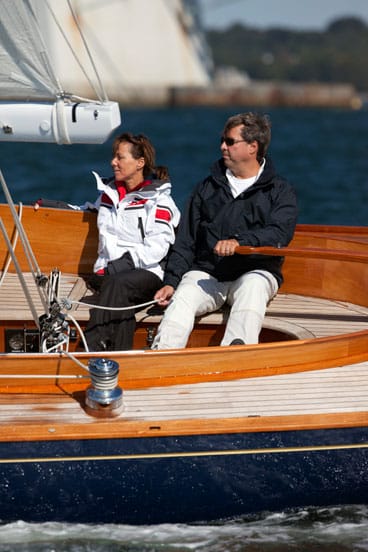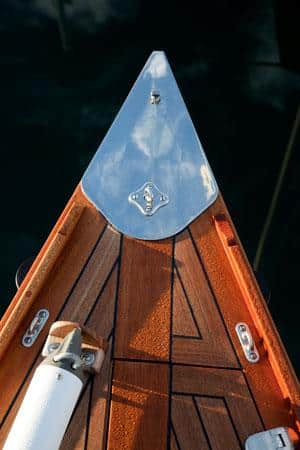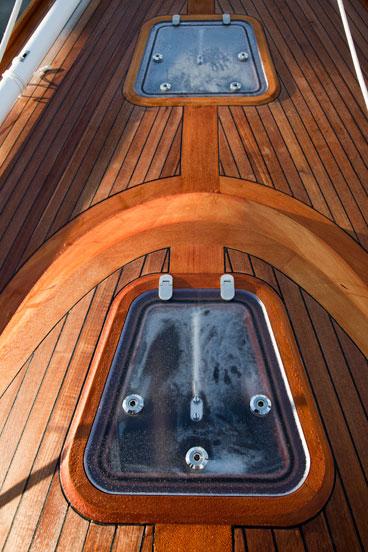
Spirit 46 Bamboozle
Like many self-professed adrenaline junkies, Tina Felix doesn’t look like one. A lawyer by profession as well as a mother of four, at first glance she seems the very essence of those solid, grounded pursuits. Her “other” personality was revealed early last fall on Rhode Island’s Narragansett Bay, where a crisp northerly gusting toward 25 knots was coursing down the East Passage. Aboard Bamboozle, the elegant Spirit 46 she owns with her spouse, Kevin, I was tagging along with the couple for the short but lively beat from Newport to Portsmouth, an upwind journey for which we’d prudently tucked in the first mainsail reef before setting out from the former’s protected harbor.
We were two or perhaps three tacks into it, spray flying, clawing to weather purposely at nearly seven knots, when Tina suggested we shake out the reef. Given the whitecaps and the pumping breeze, it wasn’t something that would’ve occurred to me otherwise. Kevin shrugged; reef knots were untied; the mainsheet was eased as the button for the electric halyard winch was depressed. Once everything was again squared away, we were ever so slightly overpowered and had only gained a tenth of a knot or two of boat speed, but Tina seemed satisfied.

At left: Tina and Kevin Felix
“I didn’t used to be like this,” she said. “On a day like today I’d be saying, ‘Whoa, that’s a lot of wind.’ I was a reluctant sailor. But my husband converted me. Along with this boat.”
Though the sum of my sailing time aboard Bamboozle to that moment totaled about 20 minutes, I completely understood what she meant. With her slim beam, low profile, and long overhangs, Bamboozle appeared above the waterline to be from a different era, but she was a wolf in sheep’s clothing: Thanks to a tall Southern Spars carbon rig, high-tech Quantum sails, the deep fin keel and ballast bulb, and a detached spade rudder, she trucked to weather as if possessed. And before my day with the Felixes was done, I’d come to realize that Tina was not only a convert to the pure, unadulterated thrill of sailing such an exquisite creation; she was also America’s leading ambassador for Spirit Yachts.
The company’s history is as interesting as the yacht itself. Established in the early 1990s by a lifelong water rat named Sean McMillan who learned his ropes off England’s rugged southern coast and the Thames Estuary (“If you can sail there, you can sail anywhere”), the enterprise was launched after its founder ditched his gig running a London ad agency to follow his passion for designing and building boats along the shoreline of his youth.

“Spirit is a pretty well known brand in Europe and the United Kingdom, but this is our first foray into the United States,” he said last September while exhibiting Bamboozle at the Newport International Boat Show. “We started 17 years ago with the intention of building very beautiful, modern, classic boats. I just don’t see why all modern boats have to be fat, white, and plastic. There are other alternatives.”

“The most important decision we made,” he continued, “was not to go down the pastiche route, to just try and make a copy of something. The most significant thing was getting away from the long keel/keel-hung rudder configuration that all classics had. If you start with a ‘narrowish’ boat—but not uncomfortably narrow—with a firm turn in the bilge so it’s got good form stability, and shallow rocker, you’re making a small hole in the water, with very efficient foils and a very efficient rig. You can’t really miss, frankly. Wrap it all up in a very beautiful package, and thankfully, I’m pleased to say, we’ve now built 50 boats of varying sizes, and they’ve been very well received.” Spirit offers yachts measuring from 46 to 130 feet, and it’s recently introduced two new deckhouse models, the DH 50 and 57.
What also separates Spirit from almost every other builder of traditional-style series yachts is the boats’ wood/epoxy construction. “I’ve been building boats this way for about 25 years now,” said McMillan, “and have gradually perfected a technique where we could get the hulls lighter and lighter and lighter in weight” without sacrificing structural integrity.
Like all Spirits, the 46 is built on laminated ring frames usually fashioned from Brazilian cedar, a strong, dark hardwood that looks like mahogany but at half the weight; the keelson is Oregon pine. The first layer of planking on the 46 is also Brazilian cedar (on bigger boats that are less weight sensitive, the choice is Douglas fir), and it’s glued to the ring frames to form a monocoque structure that’s then faired before a series of double-diagonal, cold-molded veneers are applied. The builders add a layer of glass/epoxy to stabilize the surface prior to the Awlgrip finish.

The deck is swept teak; the brightwork is highly varnished Brazilian mahogany; everything is bonded by West System Epoxy. The keel is an SG steel foil to which a torpedo-shaped lead ballast bulb—a whopping 45 percent of the boat’s 9,900 pounds of displacement—is bolted. The stainless-steel rudderstock supports a finely tuned, foam-filled, balanced spade rudder encapsulated by a carbon skin. Custom hardware abounds. The attention to detail is staggering. The end result is irresistible.
At least it was to Kevin Felix, a banker who loved his J/100, but was “looking for something a little different.” His bride, however, needed a bit of persuasion before she warmed to the idea.
Kevin said he “stumbled” upon Spirit Yachts by happenstance, while surfing Internet classifieds for used boats. Intrigued, he looked up the company’s website and decided to pay a visit to their boatyard in Ipswich, where he inspected the yachts under construction, and met McMillan, in whom he discovered a kindred soul. They started corresponding. Another trip to England ensued. Tina remained skeptical.
“Kevin wanted the boat,” she said, “but when I looked at the price tag, I thought, ‘With that, I could have another 4,000 square feet of house.’” Ultimately, she made a trip to Ipswich on her own.
“That did it,” she said. “I got it.”
Like most Spirit owners, the Felixes returned to the yard as their boat, the tenth 46 to be built, came to existence before their eyes, an experience that McMillan strongly encourages. “They’re virtually custom boats,” he said. “You can have any interior you want. It’s not like buying one off the shelf. The owners have to work with us for a year or 15 months or more to create this thing, and that’s a big commitment. The more they come to visit, the better we can keep coming together to stay on exactly the same track they want.”
For his part, Kevin enjoyed every moment of the process. “It’s amazing to see the various stages, from a stack of wood in the corner to a set of ribs, then a planked hull, and finally the finished boat,” he said. “It was something to watch it take shape.”
While McMillan said he’d delivered prior 46s with several different interior accommodations—an open floor plan, one cabin, and two cabins—the Felixes chose a rather standard layout with a V-berth and head forward, a pair of opposing settees and dining table in the central saloon, and the galley and navigation station, to port and starboard, respectively, at the foot of the companionway. The joinery work is remarkable; the 46 is literally a yacht where one “takes the furniture” sailing. The one and only thing the boat lacks down below is a place to stand up; headroom is about five feet two inches.

At left: Bamboozle’s interior
“It’s a compromise,” Tina admits, “but it fits the way we really use the boat, which is for daysailing and as a weekend cruiser.”
To underscore the fact that the Felixes’ 46 is optimized for sailing and that they spend the majority of onboard time topside, Bamboozle’s cockpit is two feet longer than those on her sister ships. She’s also the only Spirit to be tricked out with Harken hardware, which Kevin specifically requested. McMillan required some coaxing to alter his usual package of Andersen winches and Fredriksen deck gear—“He’s a perfectionist, and it wasn’t an easy decision for him to vary,” said Kevin—but he ended up as pleased with the results as the Felixes.
As we made our way up Narragansett Bay, it was easy to see why. Bamboozle sailed like a witch.
Though our destination was dead upwind, once we were past the Newport bridge, we couldn’t resist the urge to bear away and ease the sheets, if only for a few moments. While we didn’t record the 21 knots of boat speed that another 46 notched during a race the previous year—many owners enjoy competing in the ever-growing Spirit of Tradition divisions at classic-yacht regattas—the knot meter immediately ascended into double figures, topping off at nearly 11 knots. Unfortunately, too quickly we hardened up back on the breeze; we would’ve soon been halfway to Block Island otherwise.
At my suggestion—I was interested to see what difference it would make, if any—we tucked the first reef back in and were able to lock in the mainsheet and forgo easing it in the puffs to luff the sail. The boat seemed a bit happier, her rudder a tad less loaded, and we gained a few more tenths of speed, up to almost seven and a half knots. McMillan had said Bamboozle was “a pretty slick performer,” so it wasn’t shocking to note that she was extremely close-winded, tacking through 60 degrees. What was surprising, given the rather sporty weather, was her nearly dry deck. Thanks to her light ends and a bit of flare to her bow, rather than plow through the chop, she rose ever so slightly and gracefully up and over each passing wave. It felt like a curtsy. She appeared to be enjoying the outing as much as we were.
The best part of all, of course, was driving. Like an old 6-Meter or 8-Meter, Bamboozle was devoid of lifelines; not only were the sight lines forward clear and unobstructed, but the absence of railings also heightened the sensation of speed and one’s proximity to the water rushing by. It was practically hypnotizing, not to mention addictive. To command a boat this long, lean, and nimble, with a feathery-light tiller, was nothing less than pure joy.
After all, anyone can put an addition on the house. Engaging the elements, becoming one with them, on a yacht that defines the word “uncompromising” is another matter altogether.
Much too soon, the marina hove into view, so we threw in one last tack, luffed up, dropped the main, and motored in. The boat is no slouch under power, either, registering a solid seven knots at 2,500 rpm. Tying up was a letdown. Things became too quiet. Evidently, my adrenaline had been flowing, too.
Part daysailer, part cruiser, part racer, and part classic—it occurred to me that the Felixes’ Spirit 46 is a boat that has multiple personalities.
And as Tina Felix knows, when the mood strikes, just about any old time, you can shake her reef out.
Herb McCormick is CW’s senior editor.
LOA 46′ 3″ (14.15 m.)
LWL 33′ 10″ (10.3 m.)
Beam 9′ 3″ (2.83 m.)
Draft 6′ 6″ (2.0 m.)
Sail Area (100%) 684 sq. ft. (63.54 sq. m.)
Ballast 4,464 lb. (2,024 kg.)
Displacement 9,920 lb. (4,499 kg.)
Ballast/D .45
D/L 115
SA/D 23.7
Water 25 gal. (94 l.)
Fuel 13 gal. (50 l.)
Holding 6 gal. (22 l.)
Mast Height 61′ 0″ (18.59 m.)
Engine 18-hp. Yanmar GM-20
Designer Sean McMillan
Price $600,000
Spirit Yachts, +44-1473-214715, www.spirityachts.com








